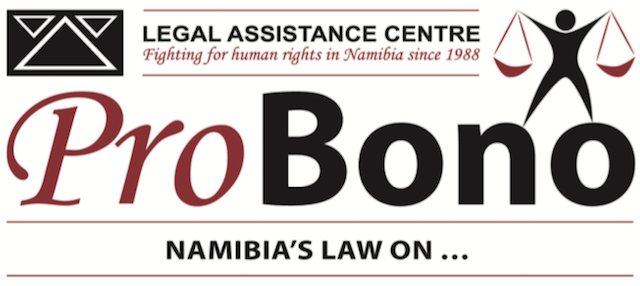MANY CITIZENS have welcomed the crackdown on crime in initiatives such as ‘Operation Hornkranz’ and ‘Operation Kalahari Desert’, but these operations have unfortunately also given rise to reports of abuses of force by individual members of the relevant armed forces, including the fatal shooting of a Zimbabwean taxi driver last year.
Concerns about the excessive use of force during these special operations have been cited in press statements by various organisations, such as the Legal Assistance Centre, the Society of Advocates and the Namibian Law Association, and have drawn critical comments from Namibia’s ombudsman and various opposition political leaders.
It is important to emphasise that the concern about excessive use of force in connection with law enforcement is not confined to the recent operations. It was reported that 118 shooting incidents involving police officers were investigated by the Namibian Police’s Internal Investigative Unit between 2010 and mid-2016, with all of these resulting in criminal charges – 34 charges of murder and 84 charges of attempted murder.
This points to an endemic problem. The task of readying law enforcement personnel to use force appropriately is important, but challenging. Police must run towards danger when others are running away from it, and they have to make split-second decisions in the heat of the moment.
It is not easy to find the right balance in formulating legal standards that will protect the public while at the same time enabling the police to combat crime effectively and apprehend suspects safely.
The Legal Assistance Centre recently released a desk research report on the use of force by law enforcement officers in Namibia. It looks at the current legal framework, the key international standards and some comparative law models, with a view to considering whether Namibian laws on the issue might be improved.
There are various international and regional standards on the use of force, but they all reflect six common themes.
The first principle is legality, which means the power to use force needs to be based on law and applied to serve a legitimate objective.
The second principle is necessity, which requires that the use of force must be unavoidable, must be limited to what is required to address the situation and must be applied only to avert an immediate threat.
Prevention is another recurrent international principle. Once the use of force is being considered, it may be too late to rescue the situation. In order to save lives, all possible measures should be taken “upstream” to avert situations where force needs to be considered.
The principle of proportionality mandates a balance between the benefits of the use of force and the possible consequences that could ensue. In other words, no life should be put at risk unless it is for the purpose of saving or protecting another life.
Law enforcement officials have a duty to respect the human rights of all persons, without discrimination. This includes direct discrimination, when a person is treated less favourably because of a personal characteristic such as ethnicity or sexual orientation, and indirect discrimination where an apparently neutral provision or practice puts a person with a particular personal characteristic at a heightened disadvantage.
The sixth international principle is accountability, which requires that individual law enforcement officers must be held responsible for any failure to comply with the legal framework. Moreover, accountability means that the planning and preparation of law enforcement operations must seek to prevent the need for force.
Accountability also requires having proper policies and procedures in place on the use of force and firearms, as well as adequate training for all personnel which is continually evaluated to ensure its effectiveness.
Law enforcement officers, like anyone else, are protected by the principle of private defence, which justifies the use of reasonable force to protect one’s own life and safety or the life and safety of another person. This common-law defence is supplemented by various legislative provisions aimed at law enforcement activities.
The most worrying provision in the current Namibian law is section 49 of the Criminal Procedure Act 51 of 1977, which considers the permissible use of force in effecting arrests.
The law authorises the use of deadly force by law enforcement personnel against someone attempting to evade an arrest for a range of listed offences – including some crimes which would not appear to involve immediate threats to public safety, such as counterfeiting, fraud, forgery, receiving stolen goods, consensual sodomy and bestiality. It is impossible to argue that the use of lethal force in such instances would satisfy the principle of proportionality.
The Police Act also touches on the use of force, permitting “such force as is reasonable”, with no mention of necessity, proportionality or preventative measures.
It has been supplemented by the much more detailed Nampol Operations Manual which embodies the relevant international principles – but the discrepancy between the law and the operational guidance is problematic.
In contrast to Namibia’s legal framework, the current South African law on arrests incorporates the requirements of reasonable necessity and proportionality in respect of situations where a crime suspect is resisting arrest or attempting to flee.
Deadly force is justifiable only if the suspect poses a threat of serious violence to someone, or where the suspect is reasonably suspected of having committed a crime involving the threat or infliction of serious bodily harm and there are no other reasonable means of effecting the arrest at that time or later.
New Zealand makes more use of tasers which produce electric shocks, as an alternative to the deployment of firearms, but it has been noted that these must be used with equal caution as they can also result in serious injury or even death.
In Namibia, the Namibian Police has made use of NDF members and ex-combatants, which can be problematic since soldiers in times of war are generally expected to employ force for specific ends rather than to avoid it. International assessments have questioned the adequacy of Namibia’s training programmes.
It has also been reported that members of the public are often not aware of their rights, with some having expressed fear of being victimised or apprehended as criminals when approaching the police to report crimes.
Namibia’s law enforcement bodies should also be praised for taking steps to hold individuals accountable when they exceed the limits of justifiable use of force.
Reform of Namibian law on standards for the use of force by law enforcement personnel would be a good step forward in curbing the individual excesses that have been recently observed.
Improved laws should set clear standards which are consistent with the Namibian Constitution and relevant international guidelines, while recognising the need to retain a reasonable degree of flexibility for police discretion in uncertain situations. In order for law reform proposals to be appropriate to realities on the ground, they should be drafted by law enforcement personnel in consultation with other stakeholders.
Stay informed with The Namibian – your source for credible journalism. Get in-depth reporting and opinions for
only N$85 a month. Invest in journalism, invest in democracy –
Subscribe Now!






